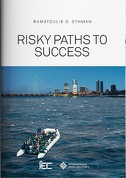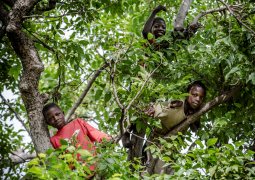
BOOK REVIEW – by Dr Cherno Omar Barry
Risky Paths to Success is an extraordinary tale of adventure full of moral lessons. It is a well-crafted and heart-breaking tale that any reader can relate to very easily. The author, Mrs Ramatoulie Othman, has skillfully captured in this short novella events worth much reflection by any concerned person. The theme, as can easily be read from the title and the image, is about immigration and the perilous journey Gambians undertake to seek better opportunities across the Mediterranean.
Generally, Gambians are known to be great travellers. For many years, the issues surrounding rural-urban drift and irregular migration to Europe, Scandinavia and the USA have started emerging in Gambian works. Prominent among them in Journey to Misery by Yankuba Mamburay and The Boat Boys by Papa Jeng. However, Risky Path to Success gives us a completely different perspective on this experience. It is a 48-page book divided into seven chapters that are not titled. However, as they read through the chapters, a keen reader would notice the crescendo in the story up to the climax before beginning to experience the satisfaction of seeing the protagonist saved. The chapters run through a coherent narration bringing us closer to understanding the reasons that led the protagonists to take the risky path to Europe. The author is wise to use much anticipation to guide the reader through an adventurous but dangerous journey which will be a form of initiation to a life of responsibility after an arduous experience for the protagonist. It is dedicated to our society's vulnerable and ambitious youths and published by the Islamic Online University. It has a cover design showing many adventurers in a sort of a rescue boat sailing towards a well-illuminated and beckoning city with high skyscrapers.
We discover in Chapter one the settings, Bambalia village, and the protagonist, Alasana Mburr. In chapter one, one notices the emphasis on the peaceful cohabitation of these inhabitants, their easy way of life and, more specifically, their religious nature. For those who have experienced village life, we cannot resist the nostalgic feeling of wanting to return to the village because life seems so peaceful, joyful and stress-free. (READ pages 6 and 7). However, amidst a life so serene and lively, there will come disruption in the life of Alasana brought by Saikou Mburr, Alasana’s uncle.
Alasana moves to the city in Chapter 2 to join his uncle, who insisted to Alasana’s grandmother that he could help the child and promised to take him to school. This sort of rural-urban drift has been common since the colonial era mainly because the Colony has always been the hub of activity and where all the senior schools were found. Even after the proliferation of schools across the country, because of the neglect in improving the livelihoods of rural Gambia, many Gambians continue the rural-urban drift. Therefore, such a drift has caused the rural areas to be depopulated, and the support that the farmer-parents needed for their farms from their children dwindled considerably. City life does not always offer a better life because children are easily influenced and indulge in petty crime, premature sex, drugs, fights, and constantly breaking the law. Alasana’s fate was no different, and he will see himself involved with many other neighbourhood youths in Serrekunda. The latter will inculcate in him depravities that will change how he perceives life in the city. However, what led to such action is true because of the way he was treated by his uncle, who made the firm promise to send him to school. (READ PAGE 12)
The author gives a good description of the type of youths the protagonist will mingle with, which begins to mark the story's turning point. Most youths have social issues due to dropping out of school, domestic abuse or other problems. The common thing was the desire to travel. Since then, Alasana began preparing to travel because, according to the author, he “wants to change his unfortunate and unhappy life for the better” (p13).
One thing that gradually creeps into the minds of youths, particularly those who come from the rural areas to stay in the urban area, is known as the ‘nerves’ syndrome. The ‘nerves’ syndrome signifies the desire to venture to developed countries such as Europe, Scandinavia or North America in search of greener pasture. Some of these journeys are made for justifiable reasons (education, visits, seeking asylum or legal migration). However, most of these journeys involve taking huge risks by frustrated youths who seek an Eldorado in these destinations and sometimes quick riches.
For Alasana to succeed in his plan to travel, he needed to adopt the bad attitudes inherent in such activities. This is explored in chapter three. He ran from home and began to embark on lucrative but dubious ventures. As a result of the bad influence of his companions, he begins to take drugs and get involved in petty thefts to survive until he begins to see himself arrested constantly for minor crimes. As he is adamant about taking the backway to Europe, he starts saving money for the journey. We learn that the youths of today take huge risks paying exorbitant amounts of cash to fishermen or go-betweens who will put them in boats to travel to Spain or Italy. For several years now, this practice has created so many irregular immigrants in Spain and Italy, as well as the northern part of Africa, that it has raised serious concern. Out of the huge number of youths attempting this dangerous journey, just a very limited number succeed and very few of those stay in Europe with legal papers to live and work. Will Alasana fall under that category? Most certainly, yes. This is what the author shares with us in chapters four to six, where Alasana succeeds in reaching the shores of Spain through a dangerous boat trip and undergoes a life-changing experience there.
We will reach the story's climax when the protagonist’s experience brings him much awareness of the futility of the risk he took to go to Spain and the amount of time wasted in his precious life.
Chapters seven onwards will help us discover the return to the homeland and the rediscovery of self. Alasana realises how much of his life he wasted when he reunites with his childhood companion and best friend, Abdul Nuru Jabal, who has almost all his dreams realised when he began building a modest business, married to a beautiful lady and with a child, and highly motivated in his convictions and believes. To quote Alasana, who was in a passionate conversation with Nuru, on pages 43 and 44, he says, “Boy, I must say this to you – what you have been able to achieve within a year at home, I went searching for abroad for over eight years.”
There is so much to learn from this well-written book as Ms Ramatoulie Othman exposes to us a few reflections we wish to share here:
- The most vulnerable children who are mostly pushed to venture on such risky journeys are abused, in families with much violence, who have little or no counselling from parents and loved ones, and suffer humiliation and social injustices. This explains why Alasana, upon his return, ended up instituting an association that would combat child exploitation and abuse. The irony here is that those who exploit and abuse children are principally their parents and family members;
- Those with a good upbringing and who have faith in Allah can be well satisfied with what they earn and feel fulfilled. This is the case of Abdul Nuru Jabal, the best friend of Alasana. He was an almudo and never had the chance to go to school, but he was well brought up and led a more respectable life.
- Another interesting character is Salimata, who also was a victim of abuse but who persisted in living a religious and dignified and later ended up studying at the prestigious Islamic Online University and changing the lives of others;
- We learn that the backway is quite a real problem and challenge but that those lucky to come back and realise the futility of the exercise on time can have a better chance of redeeming themselves and leading a respectable life.
Risky Paths to Success is not only a good read or book of moral lessons; it also offers rich language expressions and is written for academic purposes. Series of exercises are proposed at the end of every chapter that can serve to build on reading and writing expressions. I, therefore, recommend it highly for use in learning English in any institution. I take this opportunity to commend the author for being insightful in writing about rural-urban and north-south migration.
Migration is one contemporary subject worth paying serious attention to. It is easy to attach statistics to migration and much easier to advance reasons for migrations. Research has uncovered diverse reasons, most unrelated, that have caused many people to leave their countries of origin for other lands. Whereas the book under review has focused mainly on the type of migration that is considered irregular, which is dangerous, and which could be a socio-economic trap too many who venture into it, there are more advanced notions worth sharing:
- The first notion is about migration policies: where international migration policies seemed more focused on fighting poverty and reducing migration, the trend has changed considerably. To share a paradox, the Algemeen Persbureau report of September 2006 reported that 800 migrants had already arrived in the Canaries, and 9000 were intercepted on their way to the seas. Yet, in the same year, the World Bank estimates of remittances claimed remittances amounted to $167 billion, which benefits about 8% of the world population. In the case of Africa, it has surpassed all development Aid provided. In addition, there is a positive value to the social transfers (flow of information and ideas) and brain gain. Migration is therefore seen as a positive factor as it creates a balance in the labour market despite the horror stories of deaths and perils.
- The second notion is about the definition of migration. Migration signifies voluntarism, whereas displacement entails the forces beyond the mover’s control. This brings to question the purpose of the type of human movement to Europe through the perilous journeys on the sea and dangerous lands. The question is, how illegal is it?
- Despite what is commonly assumed, more than 80 per cent of African migration occurs within the Continent. In 2015, there were an estimated 21 million migrants in Africa, of which 18 million were from African countries, and the rest mostly from Europe, Asia and North America. Africa also hosts more than a quarter of the world’s refugees.
- While emigration from Africa has increased substantially over the past decade in absolute terms, the proportion of emigrants relative to Africa’s total population is one of the lowest in the world, based on available figures. The numbers of African nationals arriving irregularly by sea to Italy in 2016 represented a very small share of the total population in those countries (the highest percentage was 0.6% for the Gambia).
- Aside from increased irregular migration flows to Italy in 2015, the levels of regular migration from Africa to Europe have far exceeded the numbers of irregular arrivals and remained fairly stable over the past few years. The total steady migration inflows from Africa to Europe, proxied by numbers of first residence permits issued to African nationals, increased by about 15 per cent between 2014 and 2016.
- More data on migrants’ socioeconomic profiles and labour gaps in Europe are needed to enable the transition towards increased access to regular migration pathways. More data on the treatment of migrants in vulnerable situations in temporary accommodation facilities in some European states are also needed to ensure adequate protection of migrants.
What is evident is that The Gambia and many other African nations are facing huge challenges in controlling such migrations leading many youths to lose their lives either by dying in the seas or by being abducted on the way by bandits and being enslaved – whether sex slaves or domestic enslaved people – or tortured to death. The few who experience such atrocities and have succeeded in returning home are mostly in serious psychological trauma that can take a long to heal if it ever heals. This is a serious cause for concern, and I commend Ms Othman for vividly depicting it in her story.
I invite all present and well-wishers to continue encouraging and promoting the works of Ms Othman and other writers whose main task is educating and entertaining. Risky Paths to Success is highly recommended for reading and sharing at home, school, work and within relevant organisations.





